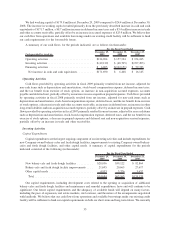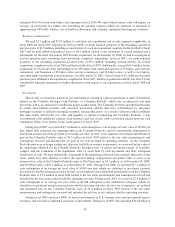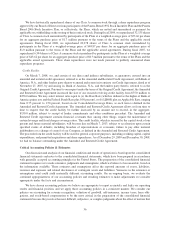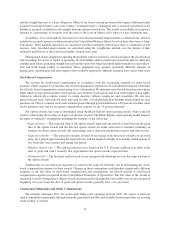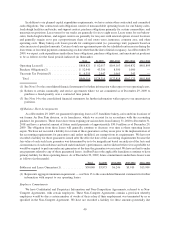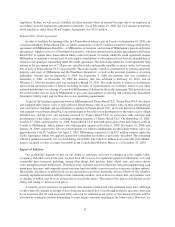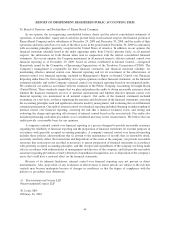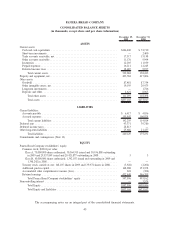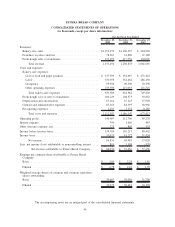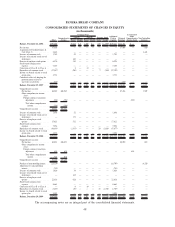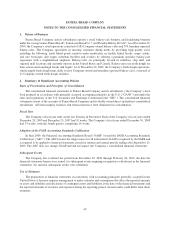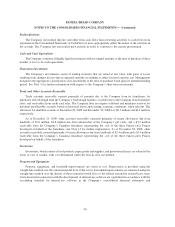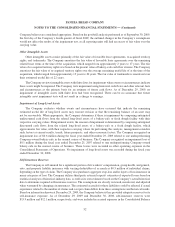Panera Bread 2009 Annual Report Download - page 48
Download and view the complete annual report
Please find page 48 of the 2009 Panera Bread annual report below. You can navigate through the pages in the report by either clicking on the pages listed below, or by using the keyword search tool below to find specific information within the annual report.have not experienced to date a significant reduction in bakery-cafe profit margins as a result of changes in such laws,
and management does not anticipate any related future significant reductions in gross profit margins.
Accounting Standards Issued Not Yet Adopted
In June 2009, the Financial Accounting Standard Board, or FASB, issued authoritative guidance on accounting
for transfers of financial assets, which is effective for reporting periods beginning after November 15, 2009. This
new guidance limits the circumstances in which a financial asset may be de-recognized when the transferor has not
transferred the entire financial asset or has continuing involvement with the transferred asset. The concept of a
qualifying special-purpose entity, which had previously facilitated sale accounting for certain asset transfers, is
removed by this new guidance. We expect that the adoption of this new guidance will not have a material effect on
our financial position or results of operations.
In June 2009, the FASB issued authoritative guidance on accounting for variable interest entities, referred to as
VIE, which is effective for reporting periods beginning after November 15, 2009 and changes the process for how an
enterprise determines which party consolidates a VIE, to a primarily qualitative analysis. The party that consol-
idates the VIE (the primary beneficiary) is defined as the party with (1) the power to direct activities of the VIE that
most significantly affect the VIE’s economic performance and (2) the obligation to absorb losses of the VIE or the
right to receive benefits from the VIE. Upon adoption, reporting enterprises must reconsider their conclusions on
whether an entity should be consolidated and should a change result, the effect on net assets will be recorded as a
cumulative effect adjustment to retained earnings. We expect that the adoption of this new guidance will not have a
material effect on our financial position or results of operations.
ITEM 7A. QUANTITATIVE AND QUALITATIVE DISCLOSURES ABOUT MARKET RISK
Commodity Risk
We manage our commodity risk in several ways. On occasion, we have entered into swap agreements to
manage our fluctuating butter prices. All derivative instruments are entered into for other than trading purposes. In
fiscal 2009 and 2008, we did not have any derivative instruments. In addition, we purchase certain commodities,
such as flour, coffee and proteins, for use in our business. These commodities are sometimes purchased under
agreements of one month to one year time frames usually at a fixed price. As a result, we are subject to market risk
that current market prices may be above or below our contractual price.
Interest Rate Sensitivity
We are also exposed to market risk primarily from fluctuations in interest rates on our revolving credit facility.
Our revolving credit facility provides for a $250.0 million secured facility under which we may select interest rates
equal to (1) the Base Rate (which is defined as the higher of the Bank of America prime rate and the Federal funds
rate plus 0.50 percent) or (2) LIBOR plus an applicable rate ranging from 0.75 percent to 1.50 percent as set forth in
the Amended and Restated Credit Agreement. We did not have an outstanding balance on our borrowings at
December 29, 2009. We may have future borrowings under our credit facility, which could result in an interest rate
change that may have an impact on our results of operations.
Foreign Currency Exchange Risk
In the fourth quarter of fiscal 2008, we expanded our operations into Canadian markets by opening two
franchise-operated bakery-cafes. We opened one additional bakery-cafe in Canada in the first quarter of fiscal 2009.
Our operating expenses and cash flows are subject to fluctuations due to changes in the exchange rate of the
Canadian Dollar, in which our operating obligations in Canada are paid. To date, we have not entered into any
hedging contracts, although we may do so in the future. Fluctuations in currency exchange rates could affect our
business in the future.
42



